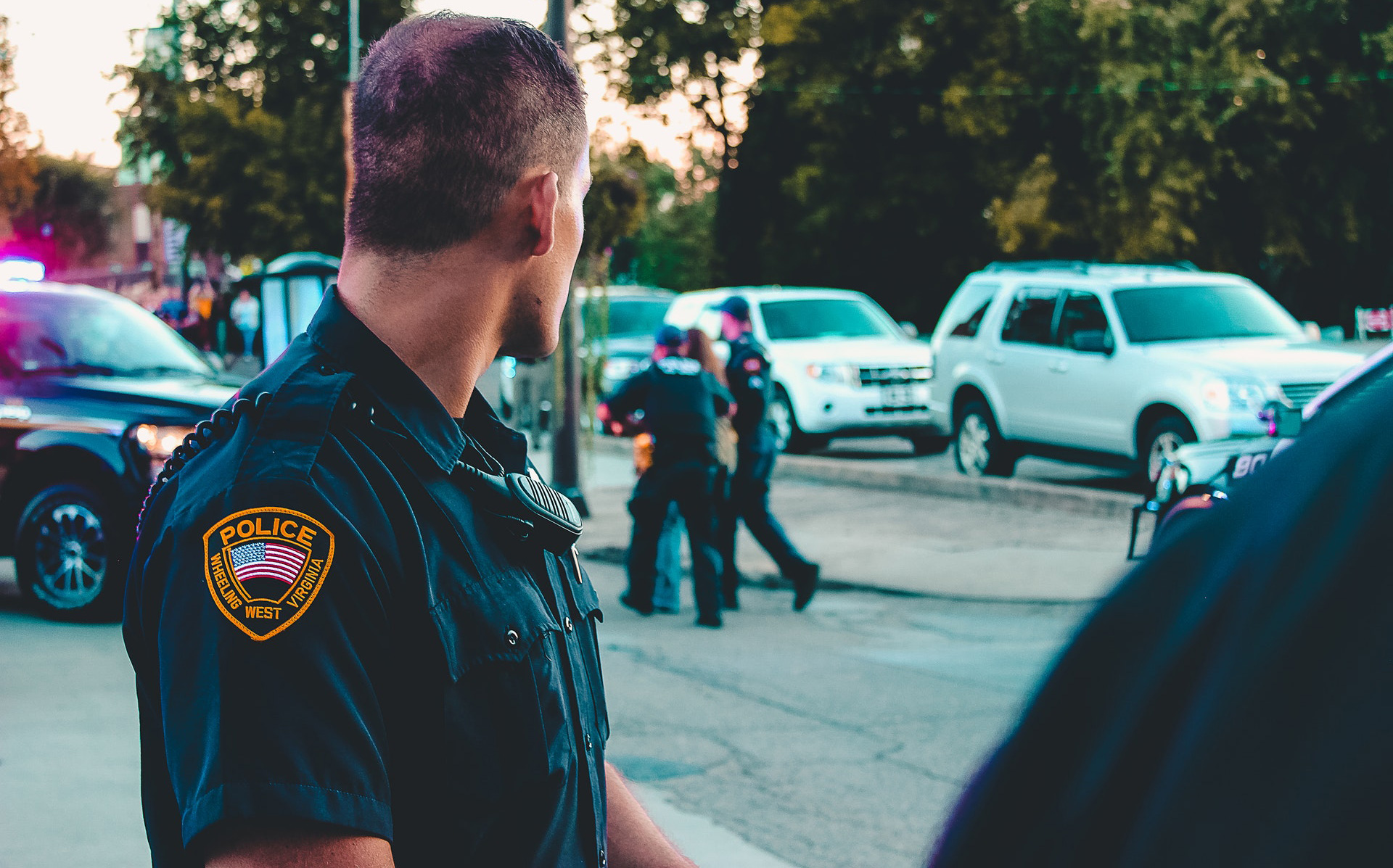A MOVEMENT THAT CONJURES THE SPECTER OF AN ENEMY THAT IT SEEKS TO ANNIHILATE
is always illegal to kill a police officer. Ismaaiyl Brinsley, who shot his ex-girlfriend Shaneka Thompson and then traveled 200 miles from Baltimore to Bed-Stuy, Brooklyn, knew this before he shot and killed two NYPD officers—and then himself. It was this incident in 2014 that sparked a purported movement under the banner of “Blue Lives Matter.” Since its inception, it has become clear that this instance of mobilization doubles both as a social movement and a propaganda arm of the police state. This unclear distinction between state and society, the political and the social, produces the optimal conditions for the police state to gain further influence over a public sphere that has already stigmatized negative feelings as expressions of (black) criminality, (black) nihilism, a case of the (black) blues, (black) pathology, or a variety of other maladjustments and antisocial tendencies.
Blackness, of course, is never merely parenthetical. Brinsley’s presumed ties to Black Lives Matter provided the fuel that enabled “Blue Lives Matter” to catch and burn. He became the metonym for a broader, incalculable threat. This transposition of a cop-shooting into an urgency to quell that uncontainable force known as black politics—a politics before and against politics itself, a politics that does not always know itself as politics, a resistive force that throws the fabric of the state into crisis—is a central operation of “Blue Lives Matter.” To see this substitution at work is to bear witness to the sorcery of the police state, and to how it summons the specter of an enemy that it seeks to annihilate.
It is always illegal to kill a police officer, but then again, murder is not the focus of recent calls to expand hate crime legislation to include actual or perceived law enforcement officers as a targeted group. Last year, “Blue Lives Matter” morphed from reactionary rejoinder to legislative plan when politicians began proposing bills to rewrite hate crime laws across the nation to include law enforcement personnel. Inasmuch as murder was the galvanizing force behind the appearance of “Blue Lives Matter,” the enforcement of this newborn legislation has required much less bloodshed. In New Orleans, where a “Blues Lives Matter” provision was first applied in a criminal proceeding—and subsequently rejected by the Orleans Parish District Attorney—injurious words were the designated crime. Racist and sexist slurs, not murder, necessitated the expansion of hate crime laws in the effort of protecting the police.
Where proponents of “Blue Lives Matter” bills see the proposals as added protection of the police, critics—chief among them the ACLU, The Anti-Defamation League, as well as legal and liberal reformists—recognize them as symbolic and reactionary posturing that appropriate the language of civil rights, undermine racial justice activism, and trivialize calls for police reform. The Anti-Defamation League, for instance, argues that the proposed legislations threaten to contaminate the legal designation of hate crimes and “deter efforts from protecting against identity-based crimes.”
But the trap of these critiques of “Blue Lives Matter” which advocate for the sanctity of hate crime laws is that they are grounded in a basic assumption that the law can provide justice. The result is precisely the aim of “Blue Lives Matter” itself: to strengthen the fiction that the law is just.
“Blue Lives Matter” is, fundamentally, a moral claim that conjures an ever-present threat “out there.” It fabricates a hatred of the police that somehow supersedes the violence and terror that the police state injects into everyday life. This moralization is enacted through a performance of vulnerability in which “Blue Lives Matter” translates a disparate array of actions, feelings, utterances, mindsets, opinions, and fantasies into a homogenous field of negative sentiments towards the police: Protest is transformed into a sign of aggression, congregating on the street into a riotous threat, self-preservation into resisting arrest. As a result, a wide range of emotive forces and entire social worlds are perceived as forms of terror directed towards the police.
This construction of terror sets the stage for the law to step in. Louisiana State Rep. Lance Harris speaks on its behalf: “In the news, you see a lot of people terrorizing and threatening police officers on social media just due to the fact that they are policemen. Now, this (new law) protects police and first-responders under the hate-crime law.” Speaking after the passage of a “Blue Lives Matter” bill in both chambers of the Louisiana legislature, Rep. Harris, the bill’s author, explains how he sought a legal response to what he describes as “a concerted effort in some areas to terrorize and attack police.” In Harris’s mind, there is a conspiracy brewing in the unmarked location of “some areas.” Whether or not such a conspiracy exists, the idea of individuals working in concert to terrorize and attack the police would be unimaginable without the performative labor that “Blue Lives Matter” enables. Under the brush of “Blue Lives Matter,” grievances before (and beyond) the law lose all distinction. We know that Christopher Dorner’s machismo is not the same as Korryn Gaines’s armed self-defense, nor is that the same as Valerie Castile’s prophetic rage. But the law must mistranslate everything into hate.
In an effort to overflow a news media already saturated with stories, images, and videos depicting monstrous murders by cops, police departments, their allies, and supporters have attempted to spread a soft image of the force on social media in recent years. The failed #myNYPD campaign is just one of the many calculated “community policing” endeavors that attempted to change the image of police in the public sphere. Soon thereafter, the evolution of “Blue Lives Matter” from social media campaign into legal statute was underway: in May 2016, Louisiana, which has the highest incarceration rate of any U.S. state and any country in the world, added police to the state’s pre-existing hate crime laws. Amending the law regulating hate crimes to include victims targeted for their “status as a law enforcement officer or firefighter,” Louisiana paved the way for Kentucky and Mississippi to sign similar “Blue Lives Matter” bills into law, effectively handing hate crime protections over to police. Not to be outdone, Arizona then passed Senate Bill 1366 that not only amends the state’s existing hate crime legislation to include “peace officers” but also extends those protections to off-duty officers.
Many critiques of “Blue Lives Matter” assert a distinction between an “immutable identity” and a chosen occupation. This effort—though seemingly effective in disqualifying police officers from protection under hate crime laws—does little to challenge the liberal discourse of hate crime itself. In 2009, activist organizations such as Black and Pink and the Sylvia Rivera Law Project spoke out about the limits of hate crime legislation. Speaking in response to President Barack Obama’s expansion of hate crime law to include sexual orientation and gender identity, the Sylvia Rivera Law Project argued that hate crime laws are part of an expansive logic of subjection; they maintain that “hate crimes legislation is a counterproductive response to the violence faced by LGBT people” due to the fact that it increases marginalized people’s interaction with the criminal justice system, legitimates imperial warfare, and displaces the need for racial, social, and economic justice.
Hate crime is a legal construction whose goal is to make criminals. It has little to do with redressing violence, and at the most basic level upholds the power of the state as the sovereign arbiter of not only the way violence is enacted, but also how it is defined. When viewed within the purview of the prison industrial complex, hate crime legislation is one node in an entangled web that constitutes pretext for punishment.
Some of us already know that the law is not justice.
We also know that the police do not simply enforce the law. The police protect the state’s monopoly on violence and establish the parameters of legitimate uses of force. This double operation is the paradox of police violence: it simultaneously affirms the rule of law and exercises the authority to act outside of the legal framework. The peculiar institution of policing is endowed with a “formless” power that conceals the state’s impotence. Like a ghost that seeks out the unruly, the police are an extralegal force.
“Blue Lives Matter” wants to give flesh to the ghostly presence of police power. It conjures the specter of an enemy that conspires to terrorize the police and threaten its existence, only to turn around and fabricate a homogenous field of animus as evidence of this ever-present threat. By producing and then gesturing towards an amorphous hatred, “Blue Lives Matter” constitutes an uninhabitable legal identity out of a repertoire of fear, dread, and trepidation. We can call this new thing blue life.
As a moral claim, “Blue Lives Matter” is predicated on the existence of blue life. And yet blue life does not exist prior to the articulation of that moral claim. Blue life is merely constituted through the anticipation of violence and the projection of criminality. Blue life is not a personhood but rather a spectral legal identity that mimics vulnerability. Blue life is no more than a figuration. Blue life effectively obscures the violent operations of police power by attempting to give it flesh. Blue life is the byproduct of a spirit possession ritual in which the formless authority of police power momentarily inhabits the body and poses as a form of life. Blue life is always under threat but can never perish. Blue life is what you get when you confuse a job for a social existence, an occupational hazard for an ontological crisis. Even more, it creates an equivalence between two disparate “sides” that are in fact not sides at all. It is impossible to inhabit the “I” of blue life. No one can be on the side of blue life. It is merely a conceit that simulates a threat in order to justify the expansion of state power.
There are infinite ways of hating the police, just as there are infinite reasons to hate individual police officers, the political authority they represent, the legal system that protects them, and the social order they preserve. Hating the police takes on a variety of forms and, like any feeling, it intensifies, dissipates, transforms, fades, and returns. It would be impossible to speak of a singular hatred of police. However, it is the belief in such a fictive thing that motivates “Blue Lives Matter.” This singular “hate” consolidates a multiplicity of experiences, affects, relations, and modes of living and dying into a fundamental enmity towards blue life.
Held under the shadow of blue life and its politics of curtailment is a knowledge of justice that goes beyond what the law can give, an understanding of (black) freedom textured by grief, mourning, and rage. The people that hurt understand that there is something to believe in buried beneath the fabrications of hate that surround blue life. The darkness that puts the apocryphal matter of blue life on edge and keeps it up at night is where we find our hope. Blue life is afraid of darkness because the dark anticipates the coming of a new day that has yet to arrive. Darkness accumulates futures that call into question the injustices of the present we live in. “Blue Lives Matter” is a desperate attempt to keep darkness at bay. But we know darkness is where rage, grief, and other negative feelings register experiences of loss and suffering, while at the same time preserving passionate attachments to a world other than this world, a world where niggas never die.






